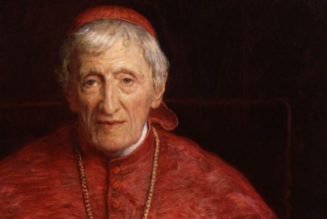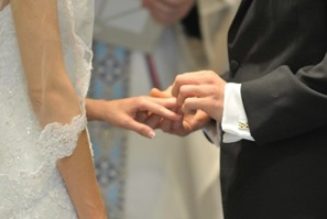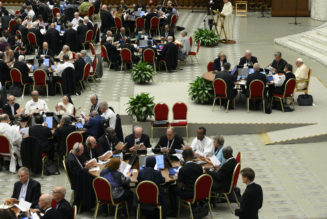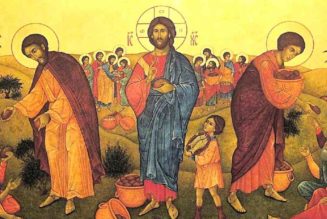There is a house down the street from us that becomes an object of annual interest to my children as the days grow short and the nights cold. When we go for evening walks, they pause before it with wide eyes. Skeletons carrying coffins march across the lawn. A spectral bride’s veil stirs in the breeze. Grinning zombies lurk in the bushes, prisoners gnash their teeth in crow cages, and monstrous spiders crawl up the porch rails. Tombstones, jack-o-lanterns, and skulls complete the macabre yet playful neighborhood spectacle that my kids behold in wonder every October.
As we took it in this year, remarking on a couple of new cadaverous additions, my son scratched his scruffy 10-year-old head and said, “Dad, what does Halloween celebrate?”
The further our culture falls away from the celebration of holy days, the more it seems to pour itself into the relentless industry of holidays. Halloween is one of those barometers of godlessness, and it comes earlier and earlier every year. Though the first in a trifecta of holy days—All Hallows E’en, All Saints’ Day, and All Souls’ Day—Halloween is no longer generally regarded as a vigil for the faithful departed. But with the loud prevalence of Halloween as a commercialized, over-the-top fright-fest, and its concentration on the attention of children, Catholic parents should have something to say to their kids about this strange, ghoulish festival—and something that isn’t simply dismissive.
Liturgically speaking, Halloween has a very natural place in the Catholic perspective. After Pentecost, the liturgical calendar enters the period of the Church on Earth, moving toward the consummation of all things in Christ the King come November. Autumn brings the festival of All Hallows’ Eve and the feasts of All Saints and All Souls, and this time of harvest captures the drama of human salvation. Halloween in particular offers a fitting occasion for the beginning of the Church Militant’s liturgy of the faithful departed, representing man’s mortality and his longing for immortality.
Halloween’s silly skeletons and hellions are expressions of why we now have Holy Ones in Heaven—because the powers of death and darkness no longer hold sway over mankind. Evil is still a force to be reckoned with, however, and the insidious and perverse have staked a claim in the customs and costumes of Halloween. With all the hyper-sexualized, psycho-slasher, torture-porn trash out there, it is clear that Halloween is not intended to reflect the aforementioned spiritual reality, unless it is spiritual death. Some things are unredeemable.
But that shouldn’t stop us. Since Halloween is basically unavoidable, it behooves Catholic parents to bless what can be blessed with what we might call the “Catholic imagination,” which is impressing a creative Catholic perspective to things that are not specifically Catholic. Halloween is actually a perfect occasion for the Catholic imagination, imagination being a commodity growing all too rare in Catholic communities. We live in an age that requires a good deal of imagination to keep the Catholic Faith as lively a thing as it should be, instead of something that just happens in church on Sunday. The Catholic imagination looks at the phantoms and fiends of Halloween festooning lawns and storefronts and turns the secular, moneymaking engines back upon themselves by giving problematic cultural expressions a legitimate Catholic understanding with a Screwtape cheekiness.
When Jesus Christ rose from the dead, death was defeated and stripped of his sting. The gates of Heaven were thrown open for holy souls to enter, and the dominion of demons was diminished by the coming of grace through the Sacraments and the Church. And so, given that triumph, the images of death and devils are now subject to a kind of Christian mockery or satirical derision. Furthermore, their playful depictions are part of the pageantry of salvation. Like the grotesque gargoyles that cling to the magnificent exteriors of ancient cathedrals, even the ugly and the evil have their place in the story of salvation—and it is a place that has lost the upper hand.
That is where Halloween can come in and should come in since it can’t be totally ignored or shut out completely. Catholics have to do something with it, so why not “baptize” it and make it work within our understanding of the world and the world-to-come rather than just condemn it as an anti-Christian pagan display or a demonic glorification of evil? We can and should do better than that by using a little imagination.
The value of any tradition lies in its pedagogical power; but that pedagogy must often be consciously or creatively applied in the work of restoring Christian culture. The implication of Halloween is that death precedes the possibility of saintly glory and the redemptive suffering of Purgatory—and it delivers this earthly message with winks, chills, and some candy. Like a good-humored rendition of Dante’s Inferno, Halloween can and should recall the darkness of error as well as the soul’s fulfillment in Christ.
I believe in the Chaucerian principle that part of the process of overcoming evil is to laugh at it—but that means allowing evil to retain its identity for the sake of our exultant ridicule. And that requires a bold Catholic attitude that looks the fearful in the eye fearlessly—and, at Halloween, the fearful take the form of vampires, werewolves, zombies, and witches. Catholics should laugh at these as symbols of overthrown evil and encourage children to enjoy their silly spectacles, even though they may be a little scary. Again, the character (or caricature) of evil should not be lost in calling out its defeat.
For this reason, saints shouldn’t replace spooks on Halloween. There is, I think, something unimaginative in All Saints dress-up parties that miss out on the significance of ghost and goblin in Catholic iconography and festivity. There is a day for the celebration of all the saints on November 1st, but Halloween is for the imps whose overthrow made way for saints to exist. Such pious costume parties are popular as a counterbalance to the often overwhelming and unfortunate horrors and obscenities of the season; and they do, of course, encourage a traditional awareness and attitude by turning the minds and hearts of children toward eternal things. But these celebrations miss out on some of the potential and delight in the Church’s liturgical poetry.
This is not to say that the good is boring, or that the thrill of evil and danger should be flirted with. Rather, there is a balance struck when villains are set up to be taken down by heroes, when the righteous asserts itself over the wicked. St. George needs his fire-breathing dragon, and salvation history needs its grinning skeletons and leering devils. Their eradication doesn’t necessarily safeguard the spiritual and the holy. Though often dismissed as uncouth, with a little imagination, lighthearted bogeys and screaming specters can serve as emblems of spiritual warfare and of the victory won in Christ. Only a partial account of salvation exists without Halloween’s jarring jesters, who do not glorify evil so much as they acknowledge it and deride their futile malice.
The reclamation of pagan or gutted Christian festivals is part of the challenge of evangelization: to orient the objectives and perspectives of secular events toward the Faith and claim another celebration for Christ on Earth. Since the festivities of Halloween are not going anywhere and are drifting into more unwholesome territory the more the devil sinks his claws into the world, Catholics need to defend their children, their Faith, and their culture from corruption by combatting base freakishness with the flair of the spiritual.
At Halloween, Catholics should draw the emphasis away from terror for terror’s sake, or the morbid fascination with evil, and move instead toward mystery, merriment, and the miraculous. Believers must not fear death, whose faith resists those materialist, walking-dead influences that declare death ultimately fearful. At the same time, we need to remember that we can’t cheat death—as the worldly mind might wish—and evil can corrupt our souls, turning men into monsters; but that doesn’t forbid the healthy human attitude of rejoicing in the power of Christ over destructive forces and our own hopeful participation in God’s grace and eternal life.
The Catholic imagination makes the campy, crude schlock of Halloween depict something vital in the reenactment of salvation history. Even though it evokes fallen nature and fallen creation, it can be informed by the liturgical rhythms of man’s deliverance from Hell. Linked to All Saints and All Souls, Halloween presents an illustration of the human passage and the consequence of Christ. Without the victory over death, there would be no saints in Heaven or souls in Purgatory. Without Christ, man would have no right to ridicule the devil. Halloween offers a comic, cultural expression of the truths that comprise man’s partaking in Christ’s Resurrection. That’s what Halloween celebrates, and that’s what we should tell our kids. Trick or treat.
[Image Credit: Unsplash]
Join Our Telegram Group : Salvation & Prosperity









